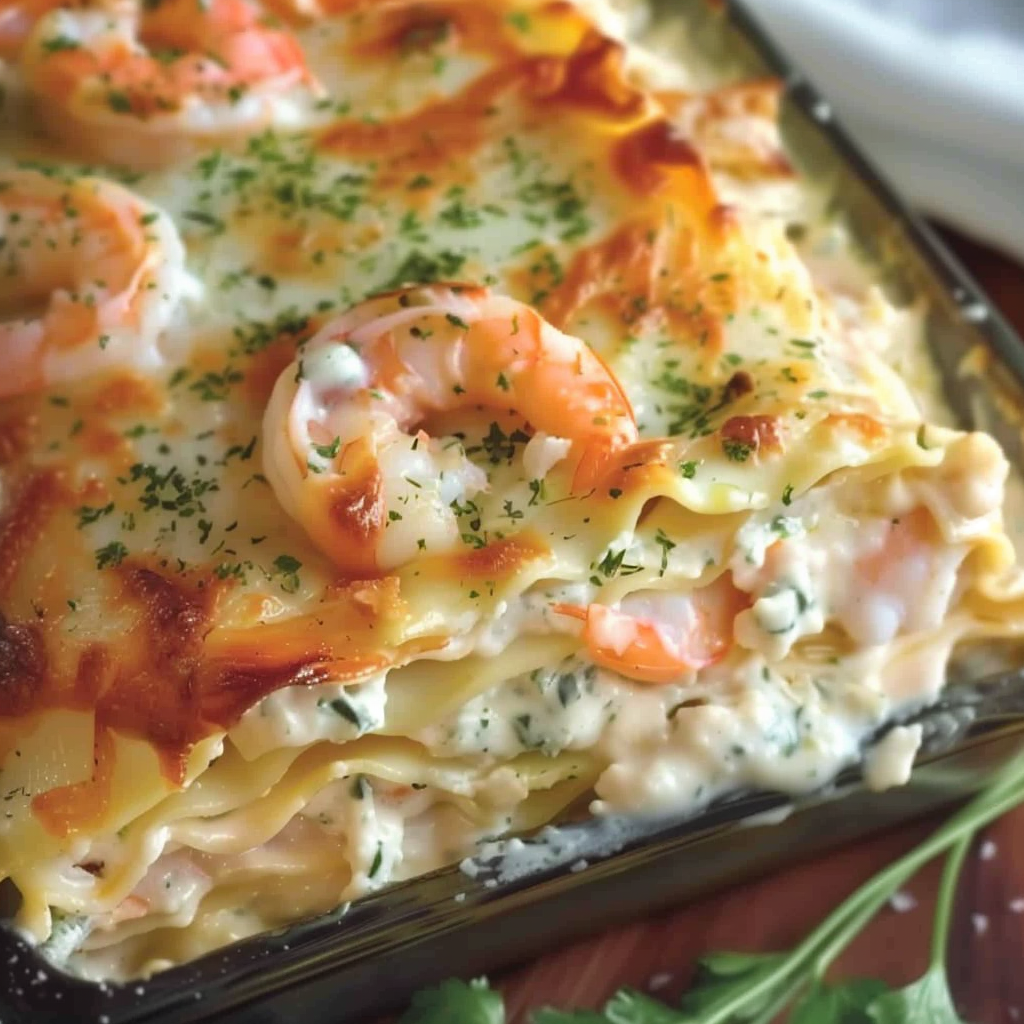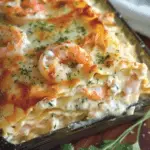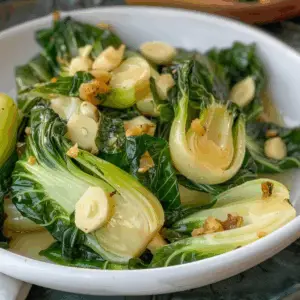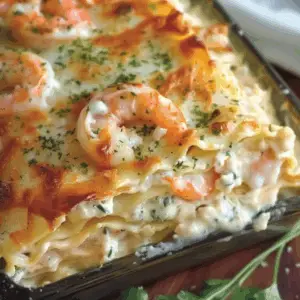Ultimate Seafood Lasagna
Seafood lasagna is a luxurious spin on the traditional Italian dish, combining the richness of creamy Alfredo sauce with the delicate flavors of shrimp and crab. This indulgent version layers tender pasta with a savory seafood filling and a parmesan-ricotta blend that creates an unforgettable bite. If you’re looking to recreate a restaurant-style seafood lasagna at home, this is the recipe that delivers in both flavor and texture.
This lasagna is ideal for occasions where presentation and taste matter—think holidays, date nights, or impressing dinner guests. The key to getting that professional-level result is choosing quality ingredients and layering them properly. With a balanced mix of juicy shrimp, lump crab meat, and a homemade Alfredo sauce, this dish brings together creamy, savory, and slightly sweet seafood notes in every forkful.
What sets this version apart from others is how it avoids the common pitfalls of seafood lasagna—no watery base, no rubbery shrimp, and no bland sauce. Techniques like adding seafood at the right stage, using the correct pan size, and layering strategically make a big difference. Plus, the use of Old Bay seasoning gives it a subtle coastal flavor that elevates every layer. According to Wikipedia, Old Bay has been a staple in East Coast seafood dishes for generations, making it a perfect fit here.
If you’re interested in how dishes like this evolved, you might be surprised to learn that lasagna has a long, rich history that dates back to ancient Greece, as noted on Wikipedia’s page on lasagne. This seafood twist is a modern adaptation of a classic that never goes out of style.
To explore similar creamy seafood recipes or plating ideas, check out this Pinterest board on creamy seafood dishes for some visual inspiration. Whether you’re a seasoned home cook or trying lasagna from scratch for the first time, this guide will show you how to master the best seafood lasagna with shrimp and crab.
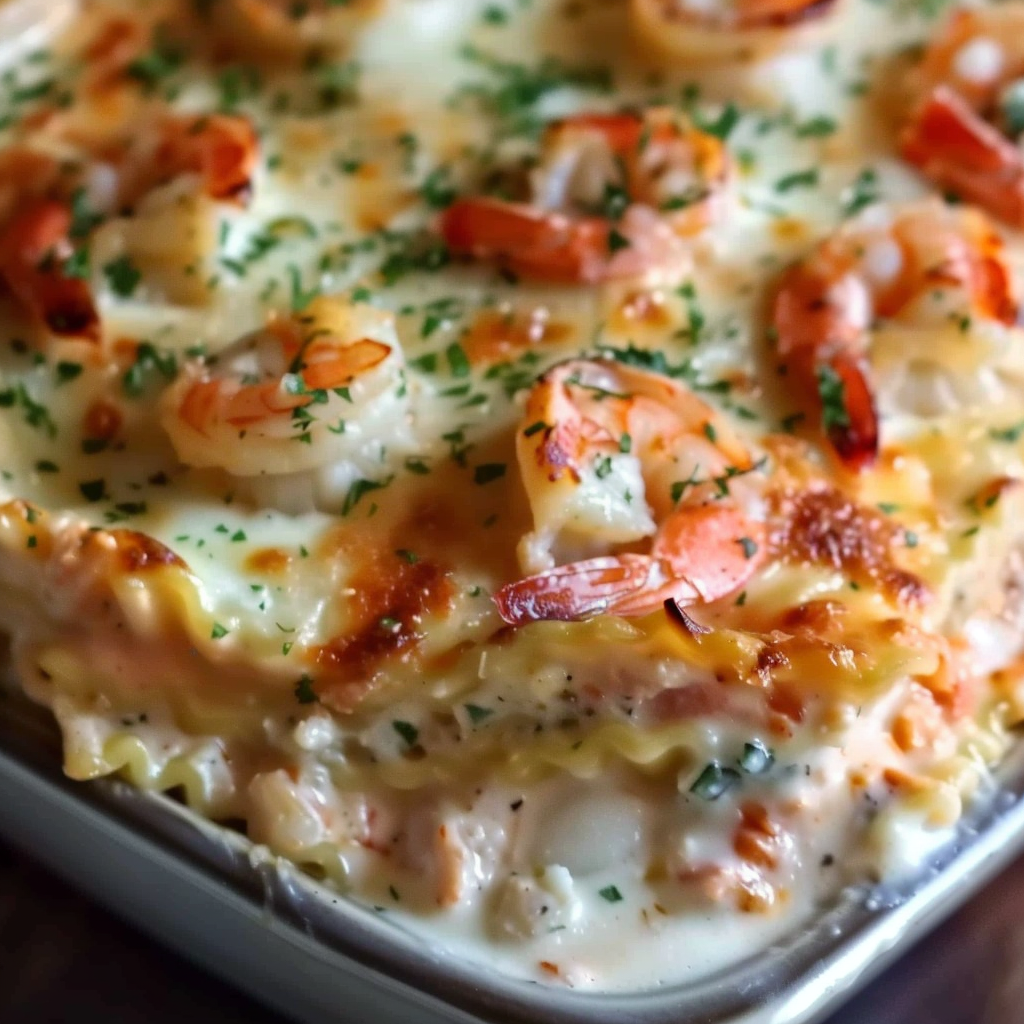
Why Shrimp and Crab Work So Well Together
Pairing shrimp and crab in a lasagna may seem indulgent, but it’s a thoughtfully balanced match in both flavor and texture. These two types of seafood complement each other beautifully, offering a contrast that makes each layer more dynamic and satisfying.
Shrimp provides a juicy, firm bite that holds up well through baking. Its slightly sweet, briny flavor pairs exceptionally with creamy Alfredo sauces, offering depth without overpowering the dish. Crab meat, especially lump crab, is more delicate and subtly sweet, almost buttery in texture. When layered together in lasagna, the shrimp’s boldness supports the crab’s lightness, creating a blend that feels indulgent but not heavy.
Beyond taste, the texture contrast adds richness to each bite. Shrimp retains a meaty texture when sautéed properly, while crab melts into the ricotta mixture and sauce, enhancing the creamy consistency lasagna is known for. This contrast prevents the dish from becoming one-dimensional or overly soft.
From a nutritional standpoint, both seafoods bring high levels of lean protein and essential omega-3 fatty acids. According to Wikipedia’s entry on shrimp, shrimp is also low in calories and rich in selenium, vitamin B12, and iodine. Crab meat, as detailed in Wikipedia’s crab meat article, is similarly nutrient-dense and a good source of zinc, phosphorus, and copper.
If you’re looking for ideas on presenting these ingredients in home cooking, you might find this Pinterest board on shrimp and crab dinner ideas helpful for serving inspiration. Whether you choose fresh or quality frozen options, shrimp and crab elevate lasagna from weeknight meal to show-stopping centerpiece.
Choosing the Right Seafood
The success of a seafood lasagna depends heavily on selecting the right ingredients—especially when it comes to the shrimp and crab. Not all seafood is created equal, and knowing how to choose, prep, and handle these key elements will make or break the final dish.
Shrimp: Fresh vs. Frozen
Fresh shrimp may seem like the obvious choice, but high-quality frozen shrimp can actually be better in many cases. Most shrimp are frozen immediately after being caught, locking in freshness. Look for raw, deveined, tail-off shrimp with no added preservatives. Avoid pre-cooked shrimp, as it tends to become rubbery during baking.
Preparing Shrimp for Lasagna
-
Peel and devein shrimp before use. This improves both texture and flavor.
-
Chop into bite-sized pieces to ensure even distribution.
-
Do not overcook during the initial sauté—shrimp should just turn pink, finishing the cook in the oven.
For more detailed background, see Wikipedia’s article on shrimp as food, which explores how shrimp is used in various global cuisines and the importance of preparation.
Crab: Lump vs. Imitation
For a lasagna that feels luxurious, lump crab meat is ideal. It offers large, tender flakes that blend beautifully into the ricotta layer or seafood filling. Here’s what to consider:
-
Fresh refrigerated lump crab gives the best texture and taste.
-
Pasteurized canned crab can be used if fresh isn’t available—just make sure to drain it well.
-
Imitation crab (surimi) is a budget-friendly option but lacks the richness of real crab.
According to Wikipedia’s page on crab meat, lump crab is one of the highest grades available and is prized for its use in gourmet seafood dishes.
Avoiding Common Seafood Pitfalls
-
Always check for shells in crab meat.
-
Pat seafood dry before adding to the filling to reduce moisture.
-
Use Old Bay seasoning for a balanced seafood flavor without overpowering.
If you want inspiration on how seafood can be featured in pasta dishes beyond lasagna, this Pinterest board on seafood pasta showcases a variety of ways shrimp and crab can elevate creamy pasta-based meals.
By choosing quality seafood and handling it with care, you’ll create a lasagna that’s not only delicious but also restaurant-worthy in both taste and texture.
Ingredient Breakdown & Substitution Tips
Crafting the best seafood lasagna with shrimp and crab involves more than just great seafood. Each ingredient in this recipe has a purpose, from structure to flavor to creaminess. Here’s a detailed look at every component—along with smart substitutions to accommodate dietary needs or pantry limitations.
Ricotta Mixture Essentials
The ricotta cheese mixture adds richness and creaminess while helping bind the layers.
-
Use whole milk ricotta for the creamiest texture.
-
Mix in one egg to help firm up the cheese when baked.
-
Add Parmesan, parsley, salt, and black pepper for depth of flavor.
Substitutions:
-
Swap ricotta with cottage cheese for a lighter texture (drain it first for less moisture).
-
Add a handful of baby spinach for a Florentine twist.
Explore more about ricotta cheese and its traditional culinary uses, especially in Italian pasta dishes, to understand why it’s such a staple in lasagna.
Alfredo Sauce Ingredients
A rich, homemade Alfredo sauce forms the base of this lasagna’s creamy appeal.
-
Made from butter, flour, and whole milk, this béchamel-like sauce is seasoned with nutmeg, salt, pepper, and finished with Parmesan cheese.
-
It’s thick enough to hold the layers but smooth enough to blend flavors beautifully.
Substitutions:
-
For a richer version, replace half the milk with heavy cream.
-
Use gluten-free flour to make the sauce celiac-friendly.
The origins and evolution of Alfredo sauce are detailed in this Wikipedia article, where you’ll learn how it transformed from a simple butter-cheese emulsion into the creamy version popular in North America.
Seafood Seasoning
-
A dash of Old Bay seasoning provides warmth and classic seafood flavor.
-
Additional black pepper and a pinch of salt help balance the creaminess.
For home cooks new to seafood seasoning blends, Old Bay’s history and composition offer helpful insight into how it enhances shellfish-based dishes.
Noodles and Cheese
-
Use traditional lasagna noodles, cooked just until al dente.
-
Mozzarella offers gooey meltiness, while Parmesan adds a sharp, salty finish.
-
Avoid pre-shredded cheese, which may include anti-caking agents that affect melt quality.
Customizations & Variations:
-
For low-carb diets, substitute noodles with thin zucchini slices or palmini lasagna sheets.
-
To add heat, sprinkle in a pinch of red pepper flakes or try Cajun seasoning in place of Old Bay.
Looking for visual inspiration on substitutions and creamy seafood layering? This Pinterest board on creamy seafood recipes offers plenty of ideas for customizations that maintain indulgence without compromising structure or flavor.
Each ingredient has a clear purpose in the final dish—from structure to creaminess to seasoning—so knowing your options ensures flexibility without sacrificing the recipe’s integrity.
Pan Size & Layering Tips for Perfect Lasagna
Getting the right pan size and layering technique is essential for a successful seafood lasagna. This isn’t just about presentation—it’s about achieving the perfect texture, avoiding overflow, and ensuring that each bite has a balanced ratio of seafood, cheese, and sauce.
Ideal Pan Size
-
A 9×13-inch baking dish is the gold standard for lasagna. It offers enough surface area for three full layers without overcrowding.
-
Using a smaller or deeper dish may cause uneven cooking or make the lasagna too thick, leading to watery layers and undercooked noodles.
Layering Tips
-
Always start with a thin layer of sauce on the bottom to prevent sticking.
-
Then layer in this order:
-
Cooked lasagna noodles
-
Half the ricotta mixture
-
Half the seafood mixture
-
A ladle of Alfredo sauce
-
A handful of mozzarella
-
-
Repeat the same order, then finish with a final noodle layer, the remaining Alfredo, and a generous topping of mozzarella and Parmesan.
Pro Tips for Even Layers
-
Spread each component evenly to avoid clumps or empty spots.
-
Use a spatula to press down gently after each layer to compact the ingredients.
-
Avoid overloading layers with too much sauce—it can cause sogginess.
Want visual examples of lasagna layering done right? Check out this Pinterest board on make-ahead lasagna meals, which includes step-by-step visuals for balanced layering and neat portions.
By following these tips and using the correct baking dish, your seafood lasagna will hold its shape, slice cleanly, and offer balanced flavor in every forkful.
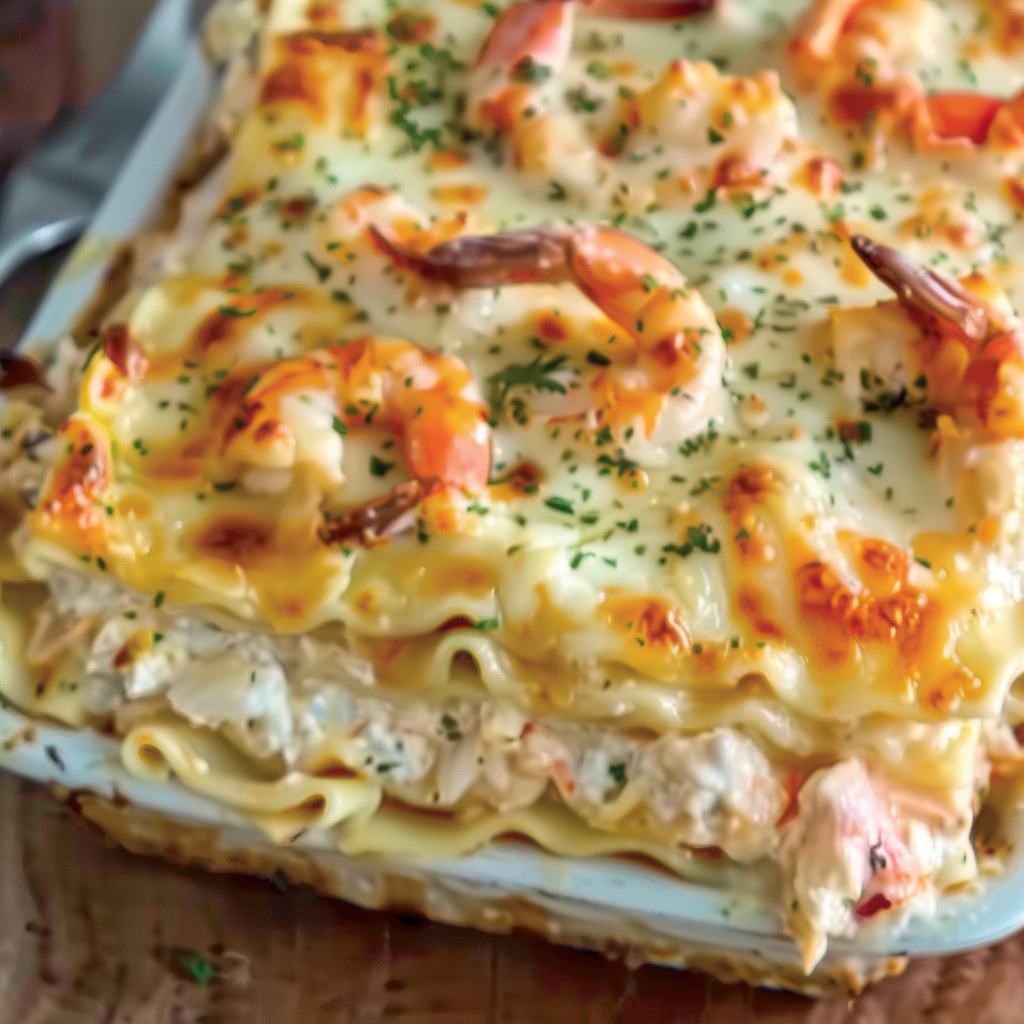
Avoiding Watery Lasagna: Common Mistakes
One of the most frequent issues with seafood lasagna is a watery base. This often comes from moisture-heavy ingredients like shrimp, crab, ricotta, or even overcooked noodles. The goal is to create a creamy but structured lasagna that doesn’t collapse or leak liquid when sliced. Here’s how to do that.
Why Seafood Lasagna Becomes Watery
-
Shrimp and crab release water as they cook, especially if not properly drained or pre-cooked.
-
Ricotta cheese contains excess moisture if not strained.
-
Using too much sauce or undercooking the white sauce can lead to separation and sogginess.
-
Not letting the lasagna rest after baking causes the layers to slide apart, pushing out excess liquid.
How to Prevent It
-
Pat the seafood dry before cooking. After sautéing shrimp and crab, let them rest on paper towels.
-
Strain ricotta cheese with a cheesecloth or mesh strainer if it looks overly wet.
-
Cook your Alfredo sauce until thick enough to coat a spoon before using it in the layers.
-
Use no-boil noodles only if you’re sure your sauce is thick; otherwise, stick to cooked noodles.
-
Let the lasagna rest at least 10–15 minutes before slicing—this allows the cheese and sauce to set properly.
For inspiration on assembling lasagna that holds its shape without being dry, take a look at this Pinterest board focused on creamy seafood recipes. Proper technique can make all the difference in transforming a runny dish into a rich, perfectly layered main course.
Mastering moisture control is crucial to turning this seafood lasagna into a cleanly sliced, restaurant-quality dish. Each bite should be creamy, not soggy.
Step-by-Step Cooking Instructions (Expanded)
Crafting the best shrimp and crab Alfredo lasagna means following every step with intention—from sautéing to layering to baking. Each stage affects the final result in taste, texture, and visual appeal.
Seafood Mixture
-
In a skillet, melt 2 tbsp of butter over medium heat.
-
Add finely chopped onions and sauté until translucent.
-
Add garlic and cook for 30 seconds.
-
Stir in chopped shrimp and cook for 2–3 minutes until pink.
-
Mix in lump crab and season with Old Bay, salt, and pepper. Remove from heat and set aside on paper towels to drain any extra moisture.
Ricotta Mixture
-
In a bowl, combine ricotta, egg, Parmesan, parsley, salt, and black pepper.
-
Stir until smooth and creamy.
-
Optional: add a bit of lemon zest or spinach for extra flavor.
Alfredo Sauce
-
In a saucepan, melt 4 tbsp butter.
-
Whisk in ¼ cup flour and cook for 2 minutes.
-
Slowly add warm milk, whisking constantly to avoid lumps.
-
Cook for 5–7 minutes until thickened.
-
Stir in Parmesan cheese, nutmeg, salt, and pepper. Remove from heat.
Assembly
-
Preheat oven to 350°F (175°C).
-
Lightly grease a 9×13-inch pan.
-
Spread a small layer of Alfredo sauce on the bottom.
-
Layer as follows:
-
3 noodles
-
Half of ricotta mixture
-
Half of seafood mixture
-
A ladle of Alfredo sauce
-
A handful of mozzarella
-
-
Repeat once.
-
Finish with noodles, remaining Alfredo, mozzarella, and Parmesan on top.
Baking
-
Cover with foil (tent it so it doesn’t touch the cheese).
-
Bake for 30 minutes. Remove foil and bake another 10–15 minutes until golden and bubbling.
-
Let rest 10–15 minutes before slicing.
Need visuals of the process? This Pinterest seafood pasta guide shows similar baked seafood dishes that showcase layering and cheese melting.
Each step builds toward a lasagna that is silky, savory, and indulgent—not overly rich, and never watery.
Serving Suggestions & Pairings
Once your seafood lasagna is hot, bubbly, and golden on top, it’s time to plate it like a pro. The right sides and drinks will enhance your dish and make it a complete meal.
Best Sides to Serve With Seafood Lasagna
-
Garlic bread or toasted baguette to soak up the creamy Alfredo
-
Caesar salad or arugula with lemon vinaigrette for brightness
-
Roasted asparagus or green beans with lemon zest to add a fresh bite
Wine Pairings
-
Buttery Chardonnay complements the richness of the Alfredo sauce
-
Sauvignon Blanc cuts through the cream with crisp citrus notes
-
Avoid overly sweet wines, which can overpower the seafood
For visual inspiration on side dish pairings and table presentation, check out this Pinterest board for shrimp and crab dinner ideas.
Pairing well doesn’t just enhance the flavor—it creates a restaurant-level experience at home.
Storage & Reheating Tips
Leftover seafood lasagna can be just as delicious the next day—if stored and reheated correctly.
Storage Tips
-
Let lasagna cool to room temperature.
-
Store in an airtight container in the fridge for up to 3 days.
-
For longer storage, wrap portions tightly in foil and freeze for up to 2 months.
Reheating Tips
-
From fridge: Cover with foil and heat in a 350°F oven for 15–20 minutes.
-
From freezer: Thaw overnight in fridge, then reheat as above.
-
Avoid microwaving large pieces, which can cause uneven heating and rubbery seafood.
Need tips for make-ahead meals and freezer-friendly prep? This Pinterest board on make-ahead lasagna meals has plenty of tricks for batch cooking and reheating with success.
Handled properly, your lasagna will retain its creamy texture and bold flavor even after being stored.
Make-Ahead & Meal Prep Options
This shrimp and crab lasagna is a perfect candidate for prepping ahead—saving time on busy days or hosting stress-free dinners.
Make-Ahead Instructions
-
Assemble the entire lasagna in the baking dish.
-
Cover tightly with plastic wrap and foil.
-
Refrigerate for up to 24 hours before baking. Bring to room temperature before putting in the oven.
Meal Prep Tips
-
Make the Alfredo sauce and seafood filling up to 2 days ahead.
-
Store components separately in airtight containers.
-
Cook and drain lasagna noodles, then toss lightly with olive oil to prevent sticking.
Whether you’re prepping for a crowd or a weeknight meal, a little planning lets you enjoy restaurant-quality seafood lasagna with minimal day-of effort.
Variations & Customizations
This lasagna is easily customized to suit different tastes or dietary needs. Below are some simple yet effective variations:
Seafood Swaps
-
Use scallops or lobster in place of shrimp or crab
-
Try imitation crab for a budget-friendly version (though it lacks the natural sweetness of real crab)
Flavor Boosters
-
Add a sprinkle of red pepper flakes for gentle heat
-
Swap Old Bay with Cajun seasoning for a Southern twist
Healthy Alternatives
-
Replace noodles with zucchini slices for a low-carb version
-
Use gluten-free pasta for celiac-friendly adaptation
Want to see how others are customizing their creamy seafood dishes? Visit this Pinterest board of creamy seafood meals for creative takes on seafood pasta.
These customizations let you tailor the dish without sacrificing that creamy, indulgent core flavor.
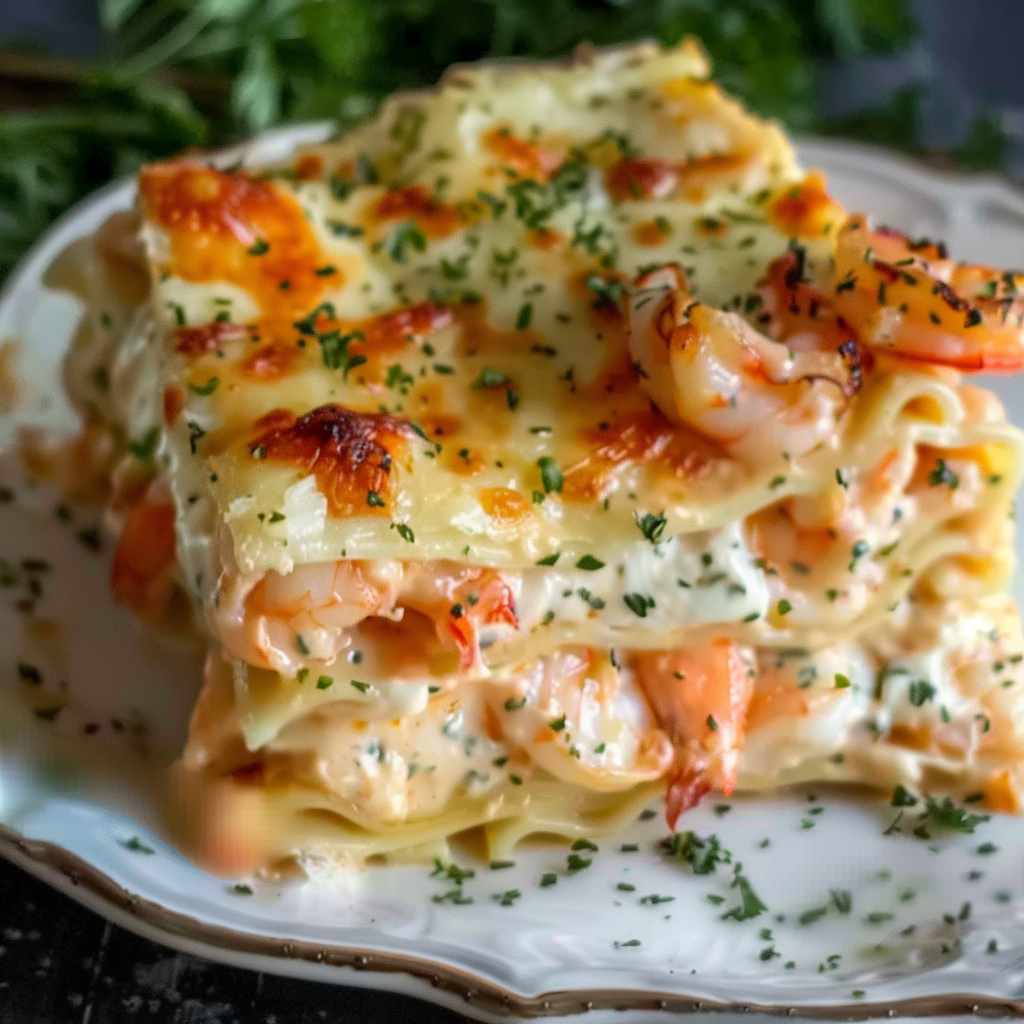
FAQs
What is seafood lasagna made of?
Seafood lasagna is made with layers of pasta, Alfredo sauce, ricotta cheese, mozzarella, and a mix of seafood—commonly shrimp and crab—seasoned with herbs and spices like Old Bay.
Can I use imitation crab meat in lasagna?
Yes, imitation crab can be used, especially for budget-conscious cooking. However, it has a different texture and flavor than lump crab.
How do you keep seafood lasagna from being watery?
Drain the seafood well, reduce excess moisture from ricotta, and let the lasagna rest after baking. A thick Alfredo sauce also helps keep layers stable.
What is the best cheese for seafood lasagna?
A combination of Parmesan, mozzarella, and ricotta is ideal. Parmesan adds depth, mozzarella gives melt, and ricotta provides creaminess.
Can you freeze seafood lasagna?
Yes, it freezes well. Wrap tightly in foil, then freeze for up to two months. Thaw overnight before reheating in the oven.
Do you cook seafood before adding to lasagna?
Yes. Sauté shrimp and crab briefly before layering. This helps control moisture and ensures proper texture after baking.
Seafood Lasagna The Best Shrimp And Crab Alfredo Recipe
Indulge in the ultimate comfort food with this Seafood Lasagna featuring Shrimp and Crab in Alfredo Sauce. Layers of tender pasta, creamy ricotta, juicy shrimp, and rich lump crab are smothered in homemade Alfredo and baked to golden perfection. It’s an elegant yet cozy dish ideal for holidays, date nights, or any special dinner. Packed with bold coastal flavor, this recipe brings restaurant-quality dining to your home kitchen.
- Author: Clara
Ingredients
For the seafood filling:
- 2 tablespoons butter
- 1 small onion, finely chopped
- 2 cloves garlic, minced
- 1 pound raw shrimp, peeled, deveined, and chopped
- 8 ounces lump crab meat (picked over for shells)
- 1 teaspoon Old Bay seasoning
- Salt and black pepper to taste
For the ricotta mixture:
- 15 ounces ricotta cheese
- 1 large egg
- 1/2 cup grated Parmesan cheese
- 2 tablespoons chopped fresh parsley
- Salt and black pepper to taste
For the sauce:
- 4 tablespoons butter
- 1/4 cup all-purpose flour
- 3 cups whole milk, warmed
- 1/2 teaspoon salt
- 1/4 teaspoon black pepper
- 1/4 teaspoon nutmeg
- 1/2 cup grated Parmesan cheese
Other:
- 9 lasagna noodles, cooked and drained
- 2 cups shredded mozzarella cheese
- Additional Parmesan for topping
Instructions
- In a large skillet, melt 2 tablespoons butter over medium heat. Add onion and sauté until softened, then add garlic and cook for another 30 seconds.
- Add the chopped shrimp to the skillet and cook for 2–3 minutes, just until pink. Stir in the crab meat and Old Bay seasoning. Season with salt and pepper. Remove from heat and set aside.
- In a bowl, combine ricotta cheese, egg, Parmesan, parsley, salt, and pepper. Mix well and set aside.
- In a saucepan, melt 4 tablespoons butter over medium heat. Whisk in the flour and cook for 1–2 minutes.
- Gradually whisk in the warm milk, stirring constantly until the sauce thickens, about 5–7 minutes.
- Season the sauce with salt, pepper, and nutmeg. Stir in 1/2 cup Parmesan cheese until melted and smooth. Remove from heat.
- Preheat your oven to 350°F (175°C) and lightly grease a 9×13-inch baking dish.
- Spread a thin layer of the sauce on the bottom of the dish. Lay 3 lasagna noodles over the sauce.
- Top with half of the ricotta mixture, followed by half of the seafood mixture, a bit of the sauce, and a sprinkle of mozzarella.
- Repeat with another layer of noodles, the rest of the ricotta, remaining seafood, sauce, and mozzarella.
- Finish with a final layer of noodles, the remaining sauce, and a generous amount of mozzarella and Parmesan cheese.
- Cover with foil and bake for 30 minutes. Remove the foil and bake for an additional 10–15 minutes, or until golden and bubbly.
- Let the lasagna rest for 10 minutes before slicing and serving.
Notes
-
Use fresh or frozen shrimp and real lump crab meat for the best flavor.
-
For a thicker Alfredo, let the sauce simmer until it coats the back of a spoon.
-
Rest the lasagna after baking for clean slices and stable layers.
-
Feel free to add chopped spinach, artichokes, or red pepper flakes for a custom twist.
-
This dish pairs perfectly with garlic bread and a crisp white wine like Sauvignon Blanc.
